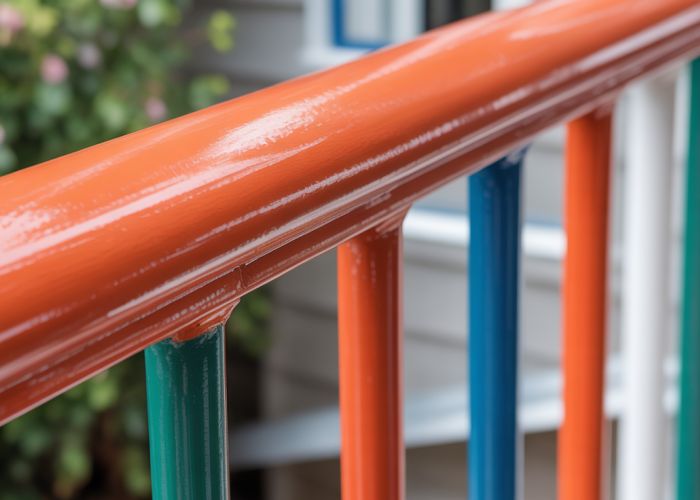Home improvement projects often involve tackling outdoor elements, and repainting metal railings presents its own set of challenges. Rust prevention, a crucial aspect of the process, significantly impacts the longevity of your railings. Selecting the right paint type determines the ultimate finish and protection. Understanding proper surface preparation is essential before the repainting metal railings begins, making or breaking the final result. Skipping these essential steps can lead to costly mistakes; this guide helps you navigate common pitfalls to avoid when repainting metal railings.

Repainting Metal Railings? Avoid These Mistakes!
This guide focuses on helping you avoid common pitfalls when repainting metal railings. Proper preparation and application are key to a lasting and attractive finish. We’ll cover everything from surface preparation to paint selection, ensuring your repainting metal railings project is a success.
1. Insufficient Preparation: The Foundation for Failure
One of the biggest errors people make when repainting metal railings is rushing the preparation stage. Skipping crucial steps like cleaning and rust removal guarantees a subpar and short-lived result.
1.1 Ignoring Existing Rust
Rust is the enemy of any metal surface. Painting over rust simply seals it in, allowing it to continue corroding the metal from underneath the new paint layer.
- Solution: Thoroughly remove all rust using a wire brush, sandpaper, or a rust removal chemical. For heavy rust, consider a power tool with a wire wheel attachment.
1.2 Neglecting Proper Cleaning
Dirt, grease, and old paint flakes prevent the new paint from adhering properly. A clean surface is essential for optimal adhesion and a smooth finish when repainting metal railings.
- Solution: Wash the railings with soap and water, followed by a rinse with clean water. For stubborn grease, use a degreasing cleaner.
1.3 Skipping Priming
Priming creates a uniform surface and improves paint adhesion, especially on bare metal. A good primer also helps prevent rust from reappearing.
- Solution: Apply a metal-specific primer after cleaning and rust removal. Choose a rust-inhibiting primer for maximum protection when repainting metal railings.
2. Choosing the Wrong Paint: Material Matters
Selecting the appropriate paint is critical for durability and longevity. Not all paints are created equal, and using the wrong type can lead to chipping, peeling, and premature failure when repainting metal railings.
2.1 Indoor Paint for Outdoor Railings
Interior paints are not formulated to withstand the harsh elements of the outdoors, such as UV rays, rain, and temperature fluctuations.
- Solution: Always use an exterior-grade paint specifically designed for metal surfaces. Look for paints that are rust-resistant and provide UV protection.
2.2 Skimping on Quality
Cheap paint often contains fewer pigments and binders, resulting in poor coverage and reduced durability.
- Solution: Invest in a high-quality paint from a reputable brand. While it may cost more upfront, it will save you time and money in the long run by providing a longer-lasting finish when repainting metal railings.
2.3 Ignoring Paint Compatibility
Using incompatible paints and primers can lead to adhesion problems and paint failure.
- Solution: Check the paint manufacturer’s recommendations for primer compatibility. It’s generally best to use a primer and paint from the same manufacturer.
3. Improper Application Techniques: Avoiding Unsightly Results
Even with the best preparation and paint, poor application can ruin the final result when repainting metal railings.
3.1 Applying Paint Too Thickly
Thick coats of paint are prone to runs, drips, and sagging. They also take longer to dry and may not cure properly, resulting in a soft and easily damaged finish.
- Solution: Apply thin, even coats of paint, allowing each coat to dry completely before applying the next. Two or three thin coats are always better than one thick coat.
3.2 Painting in Direct Sunlight or Extreme Temperatures
Painting in direct sunlight or extreme temperatures can cause the paint to dry too quickly, leading to brush marks, blistering, and poor adhesion.
- Solution: Paint on a mild, overcast day when the temperature is within the paint manufacturer’s recommended range. Avoid painting in direct sunlight or when it’s extremely hot or cold.
3.3 Neglecting Proper Drying Time
Rushing the drying process can lead to soft, sticky paint that is easily damaged.
- Solution: Allow the paint to dry completely according to the manufacturer’s instructions before handling or using the railings. Drying times may vary depending on temperature and humidity.
4. Ignoring Safety Precautions: Protecting Yourself
Safety should always be a top priority when undertaking any painting project, especially repainting metal railings.
4.1 Working Without Proper Ventilation
Paint fumes can be harmful if inhaled.
- Solution: Work in a well-ventilated area or wear a respirator mask to protect yourself from inhaling paint fumes.
4.2 Neglecting Protective Gear
Paint can irritate the skin and eyes.
- Solution: Wear gloves, eye protection, and appropriate clothing to protect your skin and eyes from paint splatters and fumes.
4.3 Disposing of Paint Improperly
Improper disposal of paint and paint-related materials can be harmful to the environment.
- Solution: Follow local regulations for disposing of paint cans, brushes, and other materials. Many communities have designated collection sites for hazardous waste.
| Mistake | Solution | Why It Matters |
|---|---|---|
| Ignoring Rust Removal | Thoroughly remove rust using a wire brush, sandpaper, or rust remover. | Prevents further corrosion and ensures proper paint adhesion. |
| Using Indoor Paint Outdoors | Use exterior-grade metal paint with rust and UV protection. | Ensures durability and longevity in outdoor conditions. |
| Applying Paint Too Thickly | Apply thin, even coats of paint, allowing each coat to dry completely. | Prevents runs, drips, and sagging, resulting in a smooth and professional finish. |
So, armed with this knowledge, go forth and give those metal railings a fresh, new look! Happy repainting metal railings – and avoid those mistakes!